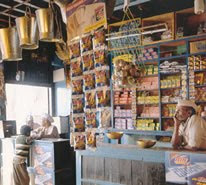In this post, I am going to review a book named “Tapping Rural Markets-Concepts and Cases” edited by Mr. V V Gopal (an IMT-Ghaziabad alumnus) and published by ICFAI University Press in 2005. It’s a tad lengthy but I am sure you will enjoy reading it.
The book provides a broad view of the rural market scenario in India as of 2005 and discusses the opportunities and challenges faced by marketers who venture into the arena. It is divided into two sections- Concepts and Cases, wherein the concepts of rural marketing and innovations and initiatives of leading consumer goods companies like ITC, Coca-Cola, HUL and LG are dicusses in detail.
Section 1: Concepts
1. Innovations in rural India- Jayatri Dasgupta
Being the source of livelihood for close to two-thirds (around 65 %) of the country’s population, rural India holds great potential for development. This article investigates why rural economy did not develop much in spite of the wide scope that agriculture and non-farming rural activities offered. Large-scale exploitation by private traders and middlemen and the lack of information dissemination to farmers on various important issues were identified as serious obstacles for rural development. Dasgupta highlights the success story of the cooperative movement in dairy production pioneered by AMUL. The setting up of agri-portals to open up information channels, distribution and procurement networks is also focused upon.
2. Understanding Rural Marketing- V V Gopal
Spotting the exciting opportunities of the rural markets, marketers are drawing elaborate plans to tap them. However, rural marketing is still at an embryonic stage. This article analyzes the reasons behind the scenario. It discusses various strategies adopted by marketers to influence the decision-making process and the buying behavoiour of the rural customer. CavinKare chik shampoo in 50 paise sachets and Coke Rs. 5 per bottle are just a few of the marketing strategies formulated by big marketers targeting the rural customers. The authoralso lays emphasis on the role of communication in promoting rural sales. He further opines that communicating in the local language captures the rural shoppers mind share as well as heart share resulting in the capture of wallet share.
3. Emerging Face of Rural Markets – Purba Basu
The rise of the rural markets has been the most important marketing phenomenon in the nineties. Leading consumer goods companies ventured into this segment the colume of growth it likely was going to offer. The article narrates how mass media have come in handy for FMCG companies to promote their products in rural markets. Various strategies adopted byu the retailers to attract the consumer. The need for product availability, enhancing awareness and increasing the buying power of the rural customers is emphasized in this article. The article also explains that product availability can affect decision of brand choice, volumes and market share. Creating awareness through advertisements, which touch the emotions of the rural consumers can drive a quantum jump in sales. Marketers are concentrating on tapping the untapped buyers which have tremendous purchasing power.
4. Tapping India’s Rural Market – Sara Huhmann
The open sale of foreign consumer products in India commenced during post liberalization period. Multinational companies view India as a market with great potential and opportunities for growth and promotion. This article addresses various issues relating to rural marketing such as understanding rural market formulating the strategies to be adopted to penetrate into segment and understanding the types of products and packages the rural consumers use. The buying behaviour of rural India revolves around the concept of ‘earn today and spend tomorrow’. Marketers are taking into account the low disposable incomes of the consumers and are coming up with unique packaging for such consumers such as ‘sachets’, priced at affordable level.
5. For a Brand New Rural India – Harish Bijoor
This article focuses on the challenges of marketing in rural India, which is multi- cultural, multi-faceted and populous. It differentiates rural India (real India) from urban India (Virtual India). The author opines that real India is today run by virtual India. It is moving very fast in the direction of the needs, aspirations, desires discovered by the man in rural India. Marketers have to adopt one of the two ways top create brand for the rural shopper – either the insensitive way or a sensitive way. Taking the urban brand and lowering the price, extending the brand to low unit packs etc constitute th einsensitive way. The sensitive way is all about taking the rough route of branding in the rural market while at the same time preserving rural India. The article suggest ways by which marketers can preserve the rural terrain but still create brands that are relevant to the needs of the rural man. It emphasizes the need to preserve the sanctity of the rural India.
6. Rural Promise - Sravanthi Challapalli
This article presents the distinct features of the rural markets and details how it is different from its urban counterpart. Rural Indians are keen to buy small packs. They are price and product conscious. They cling on to particular brand. In contrast to what is generally believed, disposable income in this segment is not low. The author opines that the yardstick applied to study urban India could provide pointers to rural India als0. Statistics show that rural India is rapidly moving from poverty to propensity opening the doors for marketers.
7. Rural Marketing is a Different Ballgame – Deepak Halan
When it comes to non-urban shoppers the marketing strategies formulated should be different from those that aim at their urban counterparts. This article narrates why establishing a rapport with rural consumers is important and discuss the research methodology that needs to be followed when catering to their needs. The author opines that identifying region-specific media, melas, developing regional messages and demonstrations facilitate the process of creating brand awareness among the rural folk. This article emphasizes that besides pffering products that specially cater to the needs of rural consumers, marketers need to understand that capturing rural markets involves focusing on low priced products.
8. Strategies for Rural Markets – T Sarathy and R Lakshmi Narayanan
The expanding rural markets are vital for the growth of many companies. Hindustan Uni Lever Ltd (HUL) is one among them. This article deals with various aspects relating to rural marketing in rural India, important among them being the market potential, rural reach and the budget allotment. Having understood the changing dynamics of the Indian market scenario and realizing that the rural consumer is now in a position to dictate terms, corporates are allocating a significant part of their budget to the rural markets. This article discusses the role of IT in this segment with reference to e-Choupal by ITC. Lack of infrastructure, low literacy levels and uncertain income of the rural consumers are some of the major challenges faced by the rural marketers.
Section II : Cases
1. ITC – M Rajshekar and Indrajit Gupta
This details the initiatives taken by this company to capture rural markets. Choupal Sagar is the first rural mall set up by the company. The outlet has an offer every commodity – from toothpastes to televisions, hair oils to motorcycles, shirts to fertilizers and many more. With its network of e-choupals, ITC gets in touch with the farmers through the Internet or VSAT lines and thus communicates the latest commodity prices. In case the farmers find these prices attractive, they sell their products to ITC. ITC has ushered in an information revolution catalyzed by choupals. The company is planning to set up a bank, cafeteria, an insurance office and a learning center to ensure that farmers visit Chaupal Sagar at all times, unlike the present situation, wherein they come only after harvest. ITC, with all present situation, wherein they come only after harvest. ITC with all its initiatives, succeeded in gauging rural consumers buying patterns.
2. Coca- Cola – K Subhadra
This details about the marketing strategy adopted by coca-cola to capture the rural market. The company proposed a strategy based on 3 A’s – Availability, Affordability and Acceptability. It adopted a hub and spoke distribution model to make coke available to rural consumers. Coke was transported to the hub from bottling plants and through them to the spokes in small towns. Coca-Cola launched a 200 ml ‘Chota Coke’ at a price affordable by rural consumers. The company ensured through its tv commercials and hoardings that consumers received and accepted them well. The case also presents the future plans of the company in penetrating further into rural markets.
3. LG – Dakshi Mohanty and T Phani Madhav
This traces the history of LG’s entry into India and examines its rural marketing initiatives. Though it had a presence in the Indian market since a few decades, LG focussed on rural marketing only from 2002. LG advertised its products all through the year. It also gave them an option of online shopping. As a unique marketing strategy, LG offered offices in the semi-urban and rural areas, known as central area offices (CAO) and remote area offices (RAO), which not only acted as sales offices but were also profit centers with decision making authority. The case details how LG succedded in its ventures by way of introducing a series of economy range products such as CinePlus along with Sampoorna CTVs and frostfree refrigerators. Through its novel strategy, “Different models, different channel”, LG operated into rural markets successfully.
4. SEWA – Reema Nanavaty
SEWA (Self-Employed Women’s Association) is a member based organization, which assists rural women producers realize the maximum financial benefits from their products and services. Out of its 1,67,000 members 1,01,000 are rural members. This article illustrates the measures taken up by SEWA to uplift the rural women who mostly come from the drought prone areas where their ability to produce goods for consumption and sale is severely affected by various factors including water shortages, etc. its strategy focuses on assisting rural women to bargain for better prices from middlemen, identifying the needs of the community and design programs that go hand-in-hand with the exiating government programs. SEWA also proposes to continuously invest in regular market surveys and market based research activities.
5. Hindustan Unilever Limited – N Gayatridevi
Project streamline is a rural distribution model for Hindustan Unilever Ltd. Owing the invasion of television, consumer awareness in rural India has increased. HUL is among companies that took rural marketing seriously. Having experienced a bitter loss in its business of toilet soaps, toothpastes, HUL realized that the future lay in tapping the enormous rural population. It then ventured into the rural markets with an intention to promote its products in the rural areas. Project Streamline was launched by the company with an objective to have an control over the rural distribution and thereby to increase the rural penetration. Then HUL went on to initiate “Project Shakti” to address the drawbacks of the project streamline, with an objective to respond to the buying behaviour of the rural consumers. It facilitated the reach and distribution process of the company. It also explains the marketshare and price of the product.
6. CavinKare – Gouri Shukla
Having understood the needs ad buying pattern of the rural consumers, CavinKare came up with an unique idea of selling its shampoo in “sachets”. The case illustrates how the company unshered in a revolution in consumer products through “Chik” – shampoo in low priced sachets. This filled the need gap in rural markets. The price sensitive rural consumer did not mind spending Re. 1 for a shampoo hair wash. The case then details CavinKare in order to consolidate its position went on to sell shampoos at 50 paise, and also launched a single use perfume at Rs. 2.


